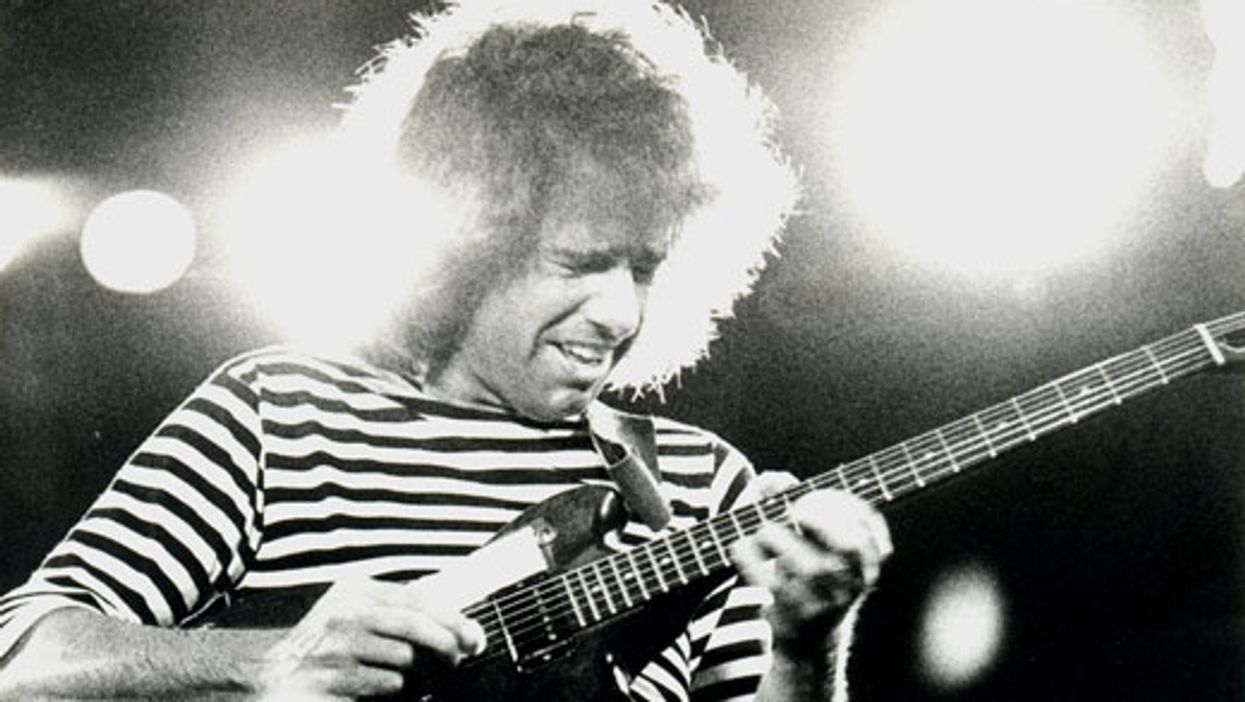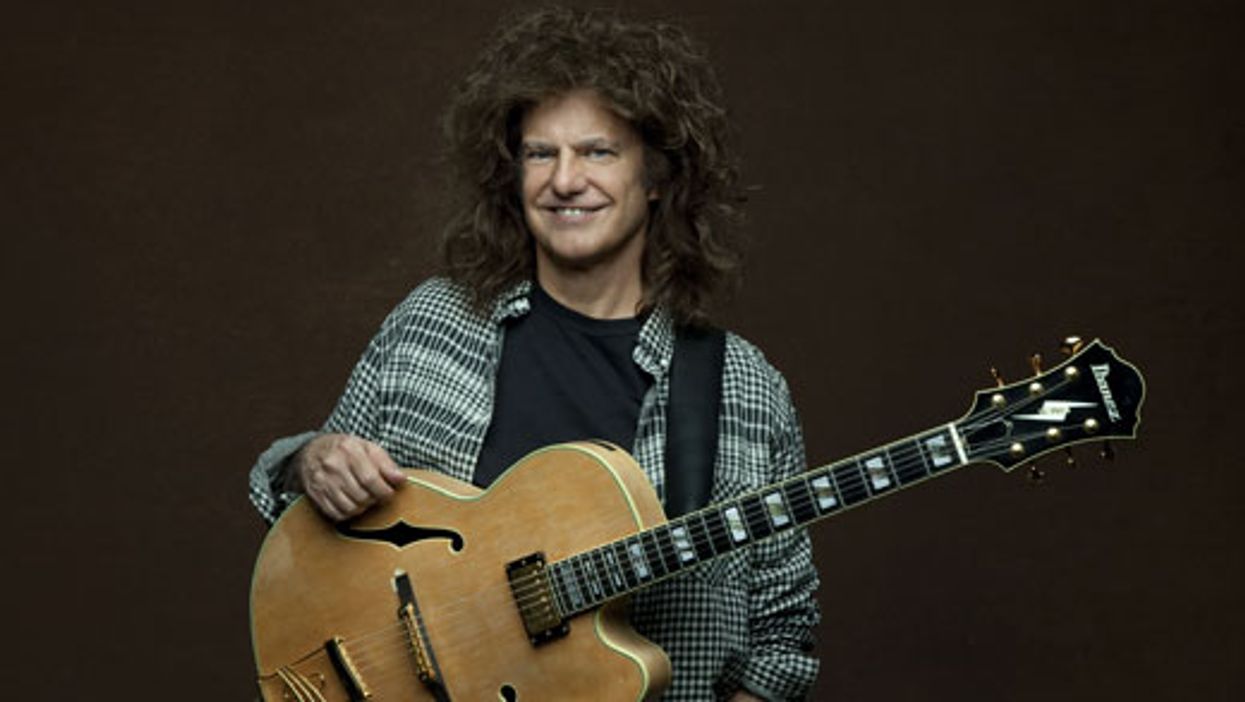Ex. 1 is about as Scofield as we can get without consulting a patent lawyer, though a good case could be made that he took this idea from pianist Thelonious Monk. You can hear this descending whole-tone-based lick in many of Sco’s solos. The notes impart a strong Bb7#11 sound and the final note is pushed off the fingerboard and returned in a vibrato-like motion. That’s another great Scofield-ism that just can’t be ignored.
Ex. 1
Turn up that chorus pedal and hone your string-skipping chops with Ex. 2, a 1980s-style 16th-note funk lick. The basic sound is G7, but with a host of alterations. The G half/whole diminished scale (G–Ab–Bb–B–C#–D–E–F) is clearly important, but it doesn’t explain everything Scofield plays. As Scofield has mentioned regarding playing over vamps like this one, “I’m not really sure what I’m doing. It’s just an in-and-out bop style.” Feel free to include chromatic approaches and blues licks as done here as well.
Ex. 2
The IIm–V–I lick in Ex. 3 shows how Scofield could extend basic bebop mannerisms into something distinctly original. It’s clear that the thinking is F Lydian dominant (F–G–A–B–C–D–Eb) over both the Cm7 and the F7 chords. Scofield would occasionally “summarize” both chords as simply F7.
Ex. 3
Scofield’s now-classic albums with Medeski, Martin, and Wood have garnered mass appeal among funk and jam band enthusiasts over recent decades. Most of his playing on these records is roots-based and you’ll hear plenty of straightforward, blues-inspired licks like this one (Ex. 4) in B minor.
Ex. 4
The B Dorian (B–C#–D–E–F#–G#–A) lick in Ex. 5 is a good example of how Scofield develops a simple motive and answers it with contrasting material. Pinch harmonics can always be used in Scofield’s style. Don’t be concerned with these harmonics generating a specific pitch or even getting them to sound perfect—the randomness is all part of the charm.
Ex. 5
Superimposing ideas in novel ways is important to Sco’s approach and a great way to generate interest over static harmonies. Ex. 6 begins with a simple root/fifth figure in Bb that’s shifted up a half-step to B, and finally resolving back to Bb at the end. It’s an effective way to establish tension and release in a line.
Ex. 6
In recent years, Scofield has embraced a cleaner tone on some of his straight-ahead recordings. Think Vox amp and no RAT. Ex. 7 is an ever-flowing line that he might play over the first phrase of an F blues. Notice how the pickup bar is a G7 idea over the C7 and the first part of measure 1 is actually a C7 line over the F7. This kind of “misalignment” is something that intermediate players often miss, trying to faithfully match the chords all the time. Before long, the music is back on track and matching the chords in a more predictable manner, at least until the eclectic use of an A major line leading into the Bb7. Finish everything up with a Sco trademark major seventh double-stop.
Ex. 7
Ex. 8 is a particularly guitaristic way to play over the second phrase of an F blues. Even though the line is fingered in the 6th position, why not use an open string? The open high E (a #11) gives us the opportunity to get a cool angular sound to the Bb7 line that would otherwise be impossible.
Ex. 8
This phrase (Ex. 9), which begins in the 8th measure of the blues, shows Scofield’s mastery of bebop language. The D7b9 lick pushes into Gm7, which begins the final phrase of the 12-bar form. The IIm–V is clearly a simple sequence from C Lydian dominant (C–D–E–F#–G–A–Bb). The big lesson here is the importance of knowing your bebop fundamentals.
Ex. 9
Now that we’ve broken out the nuts and bolts of this lesson, let’s listen to few essential Scofield tracks to get our ears right. Even jazzers were making music videos in the 1980s.
John Scofield Protocol
“Protocol” from Still Warm, has a classic fusion groove thanks to drummer Omar Hakim and bassist Darryl Jones (both of whom played with Scofield in Miles Davis’ group). Sco’s tone is wide thanks to his signature chorus sound, an often-imitated element of his style.
Wee
When Enroute landed in 2004 it instantly became a classic guitar trio album. Recorded live at the Blue Note, it featured Sco’s longtime trio of drummer Bill Stewart and mentor/electric bassist Steve Swallow. “Wee” is a “rhythm changes” tune, which isn’t that groundbreaking, but the playing takes Denzil Best’s most well-known composition to another planet.
Chicken Dog
In 1998, Scofield teamed up with funk-jazz stalwarts Medeski, Martin, and Wood for A-Go-Go, which is a standout in Sco’s discography. This was the album that introduced him to the jam band scene and informed many of his more recent albums.
























